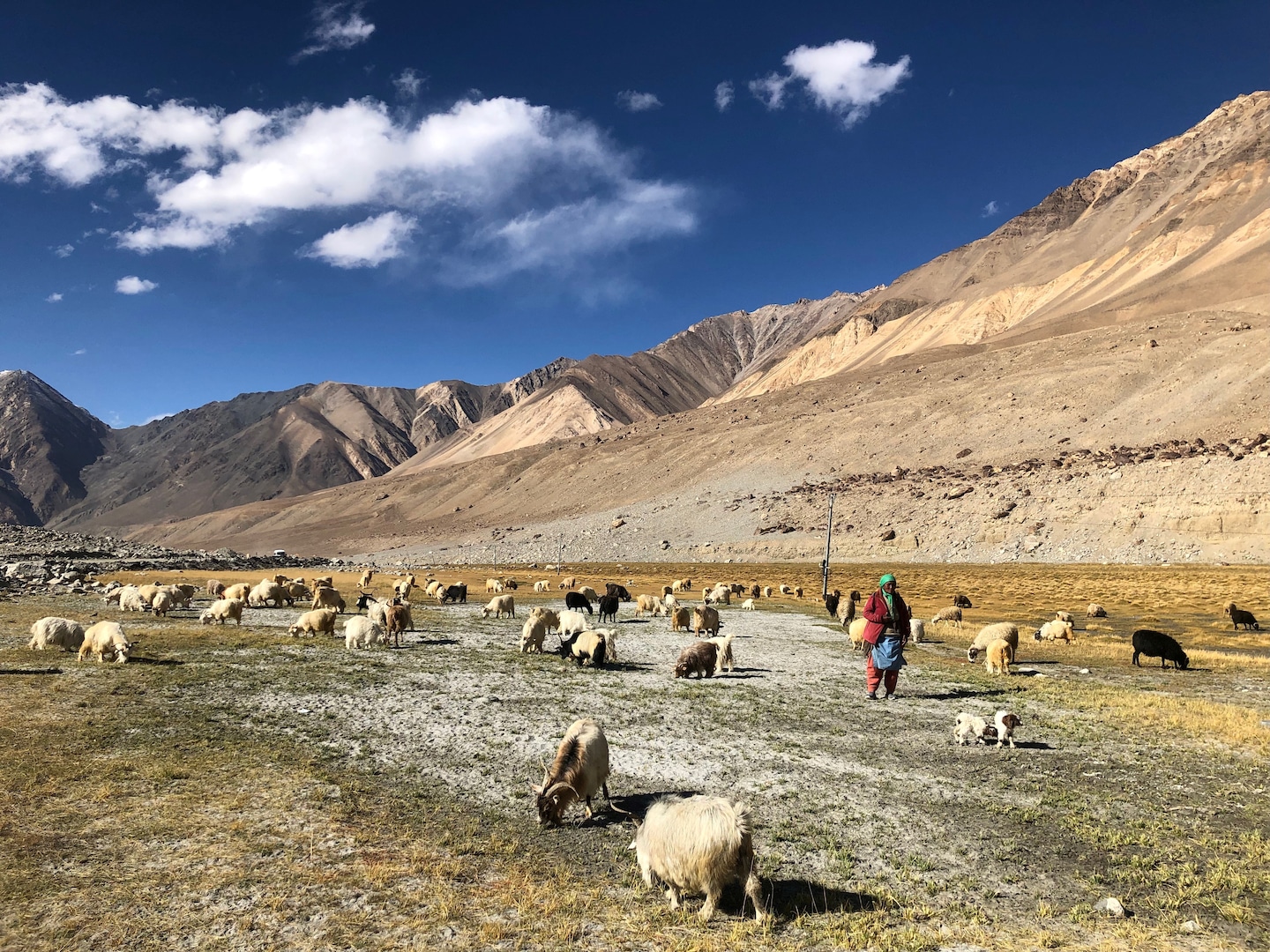[ad_1]
Angchok, now in his 70s, lives about 50 miles north of the lake. Here, too, the feeding ranges where villagers take their goats in winter have recently been put off-limits. Since this summer, the area has become part of a two-mile-wide buffer zone between Indian and Chinese troops.
Two years after India and China clashed in a series of border skirmishes, the recent establishment of buffer zones in the Himalayan region of Ladakh has been hailed as a significant step toward containing tensions between the two giant neighbors. But India’s steady withdrawal from its historically claimed areas has taken precious pastures away from the Changpas, a semi-nomadic Tibetan people famed for producing Pashmina cashmere wool — the “soft gold” once favored by Mughal royalty and Empress Josephine, Napoleon’s wife.
Sitting in the last home in Phobrang, the last Indian village before the gravel road peters out into bleak plains, Angchok seethed. “We are ceding more and more land to the Chinese,” he said.
On Sept. 9, almost exactly two years after opposing soldiers fired on one another in an alarming spike of tensions, India and China announced a retreat from Gogra-Hot Springs, a campsite that was used generations ago by traders plying the Himalayan route between Kashmir and Xinjiang, in western China. The development was praised in New Delhi and Beijing — less so in Ladakh.
“Almost all our winter grazing areas now fall under newly agreed buffer zones,” said Konchok Stanzin, a local government representative in Ladakh. “Buffer zones were created out of our land only. China has not lost anything at all.”
For centuries, the Changpas have raised their Pashmina goats in these mountains, at elevations exceeding 17,000 feet. The hardy goats grow soft undercoats renowned for their extreme warmth and light weight, and the Changpas shear the wool and transport it down to the neighboring Kashmir Valley, where families of skilled artisans weave the raw fibers on wooden looms into shimmering shawls, garments and blankets.
Ever since the 1800s, these coveted exports have been shipped from Kashmir to eager buyers as far away as Paris and London. Today, cashmere — the English word derived from the region’s name — remains synonymous with the finest wool, even if most cashmere actually comes from producers in China, Mongolia and Afghanistan.
In the Indian regions of Ladakh and Kashmir, herders and weavers on either end of the wool trade say their difficulties are mounting.
Before June 2020, when a deadly clash between Indian and Chinese troops killed dozens of soldiers and led to the closure of areas that once sustained the Changpas’ herds, a kilogram of raw cashmere cost $120. Now it’s nearly $220, according to Showkat Ahmad Mir, 41, a third-generation Kashmiri who is part of a weaving cooperative in Srinagar.
“The supply of raw cashmere wool was disturbed,” he said. “If the conflict continues, there will be a huge decline in Pashmina goats.”
The lack of grazing land has required Indian officials to step in. Ravinder Kumar, the local government secretary for animal and sheep husbandry in Ladakh, said his office this year supplied about half a million kilograms of livestock feed to the Changthang region, home to the Changpas.
“Before June 2020, there was hardly anything supplied on a regular basis,” Kumar said in an interview. “Ample pasture land was available to the Changpas.”
Tsering Sonam, 61, a Phobrang resident who used to have over 500 goats and 50 yaks, was one of the herders feeling pinched.
In summers, Sonam would take his goats to the plains near Phobrang, where they ate grass on the banks of small, glacier-fed rivulets, he recalled. By mid-November, when the temperatures in Phobrang plummet to less than minus-22 degrees Fahrenheit (minus-30 Celsius), Sonam and other herdsmen would hike with their goats and yaks for three days eastward, high into the mountains, toward China.
Eventually, herders would gather at Hot Springs and the Kugrang River valley, where fresh water and grass are found even in winter, the key breeding season for Pashmina goats. These days, those two areas are off-limits, part of new buffer zones.
Earlier this year, Sonam said he had had enough. He sold most of his Pashmina goats, keeping just five.
Stanzin, the government representative, and other local leaders say herders have recently been denied access to yet another area, making them believe that the Indian army is preparing to withdraw from a vast expanse known as Patrolling Point 16, turning a 150-square-mile swath in the Kugrang River valley into a no-go zone for locals. If the valley were vacated, herders would be cut off from an even bigger area of nearly 400 square miles, according to the local leaders, who have been voicing their fears to Indian newspapers and on social media without eliciting a response from officials in New Delhi.
The Indian Defense Ministry declined to comment for this article.
While the desolate mountains contested by India and China hold few underground natural resources, they have tributaries of important rivers, including the Indus, and strategic heights that lead into Kashmir and Tibet — two politically restive and vulnerable regions in the eyes of New Delhi and Beijing, respectively.
Military officials and analysts in China, India and the United States — which has backed India with intelligence-sharing and supplies in its high-elevation confrontation — have warned that the border remains tense, despite the buffer zones. Last month, Manoj Pande, the Indian army chief, told a conference in New Delhi that he did not see a “significant reduction” in Chinese troop levels near Ladakh. And on Dec. 9, Indian and Chinese soldiers fought with clubs and fists in Arunachal Pradesh, an Indian state farther south and east along the 2,100-mile border.
In August, India announced it was deploying amphibious assault boats to Pangong Lake. Meanwhile, on the lake’s north side, where Angchok used to take his goats, China has built radar facilities and an army base, surrounded by trenches, that could serve as a command center for a division of 10,000 troops, according to a November report by satellite imagery experts at the Center for Strategic and International Studies, a Washington think tank.
Today in Phobrang, life has been upended by the frequent roar of lumbering army trucks carrying supplies for border troops. In the home of the village chief, Konchak Stobgais also groused about the changes.
As he spoke, a low-flying Indian fighter jet shattered the stillness, leaving a trail of white vapor that stretched across the cloudless blue sky before vanishing behind a barren mountaintop.
The Indian military “sees these areas as mere wasteland,” Stobgais said. “But for us, these mountains are our lifeline.”
Shih reported from New Delhi.
[ad_2]
Source link



